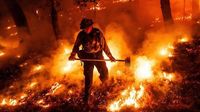Wildfires have once again upended life across Northern California’s wine country and central Oregon, as relentless flames, fueled by scorching heat and dry conditions, have forced thousands of residents to flee their homes and left many communities on edge. The Pickett Fire in Napa County, California, and the Flat Fire in Oregon’s Deschutes and Jefferson counties have destroyed homes, threatened countless structures, and put firefighters under extreme pressure as they battle not only the blazes but also the punishing weather that has gripped the region.
As of Monday morning, August 25, 2025, the Flat Fire near Bend, Oregon, had burned nearly 22,000 acres—about 34.4 square miles—according to the Deschutes County Sheriff’s Office, and destroyed four homes along with six other structures. Nearly 4,000 homes remained in evacuation zones, with 1,000 homeowners under immediate orders to leave. The fire, which erupted Thursday, August 21, during a heat wave sweeping the Pacific Northwest, has proven stubbornly resistant to containment. As of Sunday night, officials reported that no part of the Flat Fire’s perimeter was contained, despite the efforts of dozens of fire crews and equipment operators on the ground.
Deschutes County Sheriff Ty Rupert expressed both sorrow and gratitude in a statement posted to Facebook: “We are deeply saddened by the loss of homes and personal property and extend our sympathy to those affected. We are also encouraged that hundreds of homes have been protected thanks to aggressive firefighting efforts and the proactive work of property owners to reduce fuels around their homes.”
The situation in Oregon remains precarious. Firefighters continue to face significant hurdles, including difficult terrain, low humidity, and, in some areas, triple-digit temperatures. The high desert climate, dotted with dried grasses and juniper trees, has provided ample fuel for the flames, which have raced through canyon areas where containment lines are hard to establish. As Deschutes County sheriff’s spokesperson Jason Carr explained, “If we get thunderstorms that roll through, it can ... cause the fire to jump (containment) lines,” with downdrafts potentially pushing fire in multiple directions.
Meanwhile, in Napa County, California, the Pickett Fire has charred more than 6,000 acres (about 9.4 square miles) as of Monday morning, with containment at just 13%, according to Cal Fire. The blaze began in a remote area on Thursday, August 21, after a week of hot weather, and has since threatened 500 structures near Aetna Springs and Pope Valley, roughly 80 miles north of San Francisco. About 150 people were ordered to evacuate, while another 360 were under evacuation warnings. Some evacuation orders were lifted Sunday as crews made progress, but many residents remain on high alert.
Cal Fire spokesperson Jason Clay emphasized the ongoing risks: “That’s been a driving factor in the afternoons since we’ve seen the fire activity pick up for the last three days,” he said, referring to the weather. Clay noted that temperatures had moderated to about 94 degrees Fahrenheit (34 Celsius) on Sunday, but humidity was expected to drop as winds increased, raising concerns for renewed fire activity. “Support from all up and down California has been critical to our efforts,” Clay added, highlighting the scale of the response. More than 1,230 firefighters, backed by 10 helicopters, were battling the Pickett Fire as of the weekend.
The Pickett Fire’s location is grimly familiar: it began in the same area as the devastating Glass Fire of 2020, which burned about 105 square miles (272 square kilometers) and destroyed more than 1,500 structures after spreading into Sonoma County. While the 2020 blaze was driven primarily by wind, the current fire is fueled by dry vegetation on steep slopes—some of it dead and downed trees left from the Glass Fire, and some of it grass and brush that grew back after the previous disaster and has since dried out again.
The cause of the Pickett Fire remains under investigation, but the pattern is all too familiar across the West. The Gifford Fire in central California, which erupted on August 1, was the state’s largest blaze this year. As of Sunday, it was 95% contained after burning nearly 206 square miles (534 square kilometers) across San Luis Obispo and Santa Barbara counties. The cause of that fire, too, is under investigation.
Across the region, the wildfires have unfolded against the backdrop of a punishing heat wave, which sent temperatures soaring and hospitalized some residents. Dangerous heat engulfed Washington, Oregon, Southern California, Nevada, and Arizona over the weekend of August 23-24, 2025. While temperatures in some areas have since moderated, the threat remains high. Fire officials are keeping a wary eye on isolated thunderstorms in southern Oregon, which could drift north and complicate firefighting efforts by causing fires to jump containment lines.
Scientists caution that, while it is difficult to attribute any single fire or weather event directly to climate change, the broader trend is unmistakable. Human-caused warming, primarily from burning fossil fuels such as coal and gas, is making heat waves and droughts more intense, which in turn sets the stage for more destructive wildfires. According to the Associated Press, “scientists say human-caused warming from burning fossil fuels like coal and gas is causing more intense heat waves and droughts, which in turn set the stage for more destructive wildfires.”
For many residents, the experience is becoming all too routine. In both Oregon and California, evacuation orders and warnings have become a fact of life during the late summer and early fall. Some families, particularly in Napa County, have vivid memories of the Glass Fire just five years ago, and the sight of smoke on the horizon brings an uneasy sense of déjà vu. The destruction of homes—four in Oregon and an as-yet-unconfirmed number in California—underscores the personal toll of these disasters.
Yet, amid the devastation, there are glimmers of hope and resilience. Hundreds of homes in Oregon’s Deschutes County survived the Flat Fire as of Sunday night, thanks to the combined efforts of firefighting crews and property owners who had worked to reduce fuels around their homes. The scale of the response from state and local agencies, as well as the support from communities across California and Oregon, has been critical in preventing even greater losses.
As firefighters continue their battle and residents await word on the fate of their homes, the West once again finds itself at the intersection of natural disaster and human adaptation. The fires of August 2025 are a stark reminder of the region’s vulnerability—and of the need for vigilance, preparation, and, increasingly, new strategies to cope with a changing climate.


